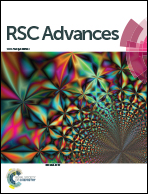One-step synthesis of hollow polymeric nanospheres: self-assembly of amphiphilic azo polymers via hydrogen bond formation†
Abstract
This article reports a facile and novel way of fabricating polymeric hollow nanospheres with azo functional groups. m-Methyl red (MMR) with a carboxyl group at the apex site could attach to random copolymer poly (acrylonitrile-stat-4-vinylpyridine) (denoted PAN-stat-P4VP), forming hydrogen-bonded brush-like polymers (HBBP) in their common solvent, tetrahydrofuran (THF). The HBBP shows unique self-assembly behavior, forming hollow nanospheres in the common solvent with increasing water content under whisking. The size and morphology of the hollow nanospheres are homogeneous and can be conveniently controlled by varying the molar ratios of the copolymers to MMR and the composition of the copolymers. DLS, TEM, SEM, FTIR and UV-vis studies demonstrated the construction and formation mechanism of the hollow nanospheres (HNSs). Compared to the conventional route to shell-cross-linked micelles and hollow spheres from the micelles composed of block copolymers, the current approach has the significant advantages of avoiding the chemical degradation of the core components and the synthesis of block copolymers. Thus, the results clearly prove that the hollow nanospheres constructed from the random copolymers and azobenzene micromolecules are a new and promising platform for the study of hollow nanospheres in solution.


 Please wait while we load your content...
Please wait while we load your content...